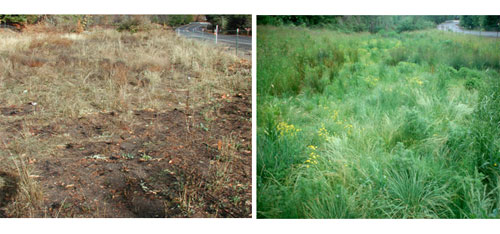ROADSIDE REVEGETATION
An Integrated Approach to Establishing Native Plants and Pollinator Habitat
Learn
Wetland Revegetation
| Location: | Intersection of Sugar Pine Road and Elk Creek Road (Forest Highway 159). |
| Lat/Long: | N42o46'37.56", W122o40'2.28" |
| Dates Implemented: | February 2001 |
| Client: | Western Federal Lands Highway Division |
| Planners: | R6 Restoration Services Team |
| Contractors: | Stone Nursery |
| Case Number: | 0009 |
| Date Submitted: | December 2008 |
| Focus Area: | Wetland Mitigation |
Background and Objectives
This was a 0.19 acre constructed wetland developed to mitigate the loss of wetland areas caused by the reconstruction of the Elk Creek Road. The original plantings of the wetland in 1998 were doing poorly, so we were asked to assess the causes and submit a revegetation plan. In a site survey that we conducted, we found that the soils in the wetland were less than 6 inches deep over a welded, pyroclastic bedrock. Coupled with this was the problem that the source of water that feeds the wetland dried up by late spring and did not return until the following fall. While the amount of water from springs and runoff was something we could not change, increasing the rooting depth with a high water holding material was a treatment that we could implement. We proposed that several feet of bedrock be removed and replaced by several feet of compost which we felt could increase the potential for certain wetland plants to become established.
Implementation
In the Winter 2001, the thin layer of soil was removed by an excavator and stockpiled. The exposed bedrock was ripped to 24 inches and hauled offsite. Compost from Stone Nursery1 was transported to the site and mixed in with the salvaged soil, then placed on the site to create a rooting depth of 24 inches. Carex and Juncus plants (referred to as "wildlings") were dug from mature stands of plants at the constructed wetland at Stone Nursery and planted on the site in the winter.
Findings
Over 50% of the wildlings that were planted failed to establish by the following spring. The cause for failure was believed to be due to the methods that they were excavated, transported, and replanted. In response to these failures, approximately 2,000 seedlings were started at the nursery from seeds and grown into seedlings. The species included Scirpus acutus, Scirpus microcarpus, Juncus effuses, Juncus ensifolius, Carex cirsicii, Carex aquatilus, and Deschampsia cespitosa. These seedlings were planted the following fall (2001) and became well established by the following spring (2002). In the subsequent years however, the composition of the species within the wetland has changed; some seedlings persisted and others faded. Several factors contributed to this 1) the weed species that were present in the salvaged surface soil proliferated forcing some planted species out, and 2) the long dry summers resulted in some plants dying where very little water was present.
Figures
The photo on the left shows the wetland site in the summer 2000. Due to the shallow soils and lack of water, vegetation was poorly established. The photo on the right shows the same area two years later after bedrock was excavated and compost was brought in.

The photo on the left shows planting of wildlings just after the site was excavated. After these plants failed, seedlings grown in containers were used to replant the area resulting in good seedling establishment.

Applicability
The findings from this project point can be used in future constructed wetland projects. Some of the things we learned was the importance of 1) having or creating deep soils, 2) not using soils that are high in weed seeds, 3) having a reliable source of water that maintains high soil moisture for at least 10 months out of the year, 4) using nursery-grown seedlings over wildlings because of the higher survival rates, and 5) planting in the fall in order to capture warm temperatures for optimum root growth.
Related Links
Experiences establishing native wetland plants in a constructed wetland (395 KB PDF)
Contact Information
David Steinfeld, USDA Forest Service; 541-552-2912, dsteinfeld@fs.fed.us
1Compost originated from grounded cull seedlings (seedlings discarded during nursery processing operations) possessing a high faction of sands.